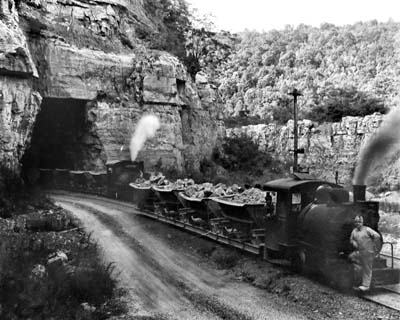Going in the Hole with Hogs
By Clarence "Junior" Knotts

Original portal at the Manheim limestone mine, later used by Preston Poultry and Feed for raising chickens,
turkeys, and pigs. Courtesy of the Preston County History House Museum.
I was born in 1931 and lived on a small Preston County farm near Aurora for the first 30 years of my life, except for a 21-month tour of duty in the Army during the Korean War.
On our farm, we always raised a few hogs for our own meat and sold a few, mostly young pigs. Hogs were often called mortgage lifters as they usually brought in extra money for farmers. So I had some knowledge of swine, but not as much as I was about to learn.
In spring 1962, I realized I needed a full-time job off the farm if I was going to provide for my family. I found work at Preston Poultry and Feed, a division of Sterling Enterprises, at Manheim, a community in Rowlesburg about six miles from my home. For those who may not know about this place, I’ll elaborate a little.
Preston Poultry and Feed raised broilers and turkeys at Reedsville and had contracts with growers in the Moorefield and Petersburg areas and in Garrett County, Maryland. The company came up with an innovative idea: converting an Alpha Cement mill at Manheim into a feed mill by putting broilers in its limestone mines.
The mines had seven to nine tunnels, some a mile long. The ceilings were about 24 feet high and 50 feet wide, and the floor sloped 20 degrees east to west and 15 degrees north to south, toward the front of the mines. They were connected by openings, or cross cuts, some of which were closed off with lumber and plastic to control the ventilation. Large fans at the mine opening forced air throughout the mines and could be controlled based on the needs of the broilers. All the tunnels had electric, and we could drive vehicles in one tunnel, from the front to the back, and through some of the crosscuts. We had about 250,000 broilers at full capacity.
There were two large water tanks about a mile back in the mines. Water was pumped from a well near the mill at the bottom of the hill to fill the tanks and then flowed back out the front to where the broilers were. The company had drilled a hole or well down from the top of the hill to where the tanks were, but they got very little water out of them.
When I went to work there, they’d just started a hog operation in the mines about a mile back from the opening. There were 12 brood sows in factory-made farrowing crates, all connected together with automatic feeders, waterers, and manure conveyers. We later made six more wooden crates so we could have 18 sows. As nature would have it, the operation soon grew to 80 or 85 brood sows and three to five male hogs.
We obviously needed some pens to hold all of these animals. Sterling brought us used wooden packing crates and German-made copper wiring from its faucet plants at Reedsville and Morgantown. We bolted a one-inch galvanized pipe about five feet long to a four-foot 2 x 4. Then we drilled holes in the limestone floor with a jackhammer to set the fence posts. After pulling the nails out of the crate boards, we made solid board fences for the various pens. All the manure was washed into concrete pits and then hauled out of the mines with a farm tractor and tank trailer.
Our plan went something like this. Every five weeks, 15 to 18 sows would have piglets—usually within three to five days. We weighed all the piglets at birth, clipped their teeth to cause less irritation to the nursing mother, and injected them with two cc’s of iron at two days and again at 10 days. We castrated all the male pigs at two weeks and moved the sows and pigs to lots at three weeks. We then cleaned the crates, hosed down and moved out the sows, and put another group in the crates. Pigs were weaned at five weeks and weighed. The sows were bred again in three to five days, starting the process over.
We gave the pigs cholera and other shots at about eight weeks and then moved them to pens near the front of the mines to be fattened for market. We administered lots of antibiotics when needed. Every sow and boar had a number tattooed in the ear, and a record was kept on each—noting the date bred and to which male, the date farrowed, the total number of pigs, shots given, etc.
At one time, we had 900 head of swine in the mines. At the farrowing site, the temperature stayed between 38 degrees in winter and 65 degrees in summer. We used heat lamps for the piglets in the farrowing crates.
You can read the rest of this article in this issue of Goldenseal, available in bookstores, libraries or direct from Goldenseal.